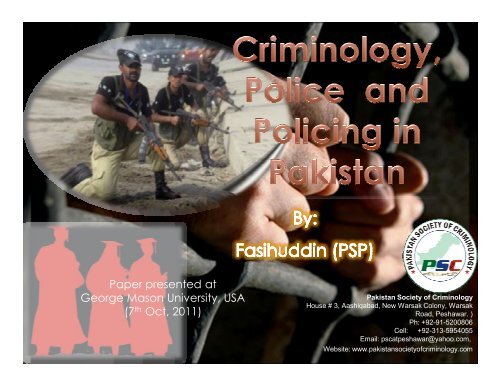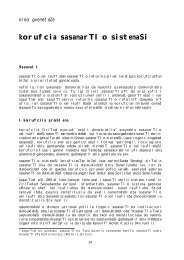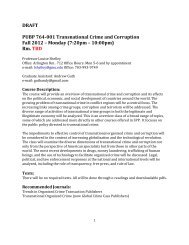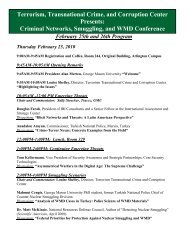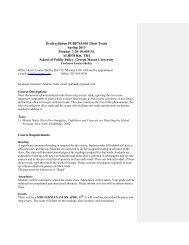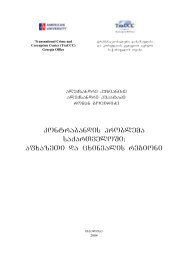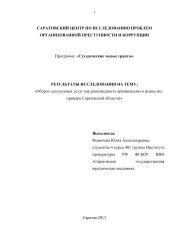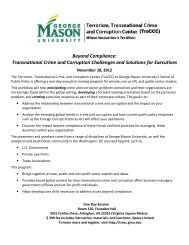Presentation - Terrorism, Transnational Crime and Corruption Center
Presentation - Terrorism, Transnational Crime and Corruption Center
Presentation - Terrorism, Transnational Crime and Corruption Center
Create successful ePaper yourself
Turn your PDF publications into a flip-book with our unique Google optimized e-Paper software.
Paper presented at<br />
George Mason University, USA<br />
(7 th Oct, 2011)<br />
Pakistan Society of Criminology<br />
House # 3, Aashiqabad, New Warsak Colony, Warsak<br />
Road, Peshawar. )<br />
Ph: +92-91-5200806<br />
Cell: +92-313-5954055<br />
Email: pscatpeshawar@yahoo.com,<br />
Website: www.pakistansocietyofcriminology.com
Pakistan<br />
Population: 177.1<br />
Million Est.<br />
Area: 796,095 sq.<br />
km,<br />
KPK Pop/Area: 23<br />
m/74521 sq.km<br />
FATA Pop/Area:<br />
4.2 m/27220 sq.km
Area (Sq. KM.) 7,96,096<br />
Population<br />
(6 th )<br />
177.1 2010 Population Reference Bureau, 2010<br />
Rural/Urban Ratio 63.2/36.8 2010 Ibid<br />
Life Expectancy at birth (m/f) 67.9/64.18 2010/2011 Economic Survey of Pakistan, 2010-11<br />
Population Growth Rate 2.05% 2010 Population Reference Bureau, 2010<br />
Income Per Capita $1,254 2010-11 Economic Survey of Pakistan, 2010-11<br />
Unemployment Rate 5.6% 2011 Economic Survey of Pakistan, 2011<br />
Below Poverty Line<br />
Educational Expenditure % of<br />
GDP<br />
literacy rate (age +)<br />
Expenditure on health as % of<br />
GDP<br />
Human Development Index<br />
(HDI)<br />
<strong>Corruption</strong> Perceptions Index<br />
Ranking<br />
75% on both<br />
sides of<br />
2011 Economic Survey of Paksitan, 2010-11<br />
Poverty Line<br />
2.10% 2008 ESP-2008-09, Chp. 10. p. 158<br />
56% (69 m, 44<br />
f)<br />
2007-08 ibid<br />
2% WHO (2009). "World Health Statistics.”<br />
128th (0.490) 2010 UNDP, Human Development Report 2010<br />
143/178 2010<br />
Trafficking in Person Tier 2 2010<br />
Transparency International (2011). Global<br />
<strong>Corruption</strong> Perception Index Report 2010<br />
Trafficking in Persons Report 2010 . P.50. US<br />
Department of State.
Total Universities in Pakistan=133<br />
(Public/Private Sector= 74/59).<br />
Universities offering Criminology as subject (3):<br />
1. Karachi University (1996). Master in Criminological Sciences<br />
(MCS)-Evening Programme<br />
2. Sindh University (1998). Department of Criminology. M.Sc.<br />
Criminology – Evening Programme.<br />
3. Punjab University (2009). Institute of Social & Cultural Studies.<br />
M.Sc. Criminology <strong>and</strong> Security Studies (two years) & Diploma<br />
in Criminology (one Year)-Evening Programme.<br />
Note: The degree course of criminology at Punjab University has started in July 2009. Sixty students has got admission in<br />
the first batch of M.Sc. Criminology.
Criminology is also offered as optional subject<br />
in the<br />
<br />
<br />
<br />
<br />
Department of Social Work,<br />
Department of Anthropology &<br />
Department of Sociology, Peshawar<br />
University.<br />
Department of Social Work, Islamia<br />
University Bahawalpur<br />
Department of Social Work, University of<br />
Sargodha.<br />
Department of Social Work <strong>and</strong><br />
Sociology, Kohat University of Science<br />
<strong>and</strong> Technology
HEC Proposed Curriculum for MSc<br />
Criminology<br />
2 years programme.<br />
1 st Semester 2 nd Semester<br />
1 Fundamentals of Criminology 1 Islamic Perspective on <strong>Crime</strong> <strong>and</strong><br />
Punishment<br />
2 Theoretical Perspectives on <strong>Crime</strong> And<br />
Criminal Behaviour<br />
2 Policing<br />
3 Methods of Research in Criminology 3 Forensic Sciences in Criminology<br />
4 Criminal Justice System 4 <strong>Terrorism</strong> <strong>and</strong> Violence<br />
5 Correctional Institutions 5 Criminal Investigation<br />
3 rd Semester 4 th Semester<br />
1 Penology 1 Human Rights<br />
2 Community Justice <strong>and</strong> <strong>Crime</strong> Prevention 2 Criminal Psychology<br />
3 Research Thesis 3 Research Thesis<br />
Source: Revised Curriculum of Criminology (2003)Higher Education Commission, Curriculum Development<br />
Division. Islamabad: Ministry of Education, Pakistan. available at HEC website, www.hec.gov.pk
SINDH UNIVERSITY, JAMSHORO<br />
Two years Post-Graduate Programme<br />
1. CRM 501* Fundamentals<br />
of Criminology<br />
2. CRM 502 Criminal Justice<br />
System<br />
3. CRM 503 Research<br />
Methods<br />
4. CRM 504 Islamic<br />
Perspectives of <strong>Crime</strong>s<br />
5. CRM 505 Juvenile<br />
Delinquency <strong>and</strong> Female<br />
Criminality<br />
6. CRM 506 <strong>Terrorism</strong> <strong>and</strong><br />
Violence<br />
7. CRM 507 Penology<br />
8. CRM 508 Criminal<br />
Psychology<br />
9. CRM 601 Policing<br />
10.CRM 602 Constitution<br />
Rights & Civil Liberties<br />
11.CRM 603 Criminal<br />
Investigation Methods<br />
12.CRM 604 Comprehensive<br />
Viva-Voce<br />
13.CRM 605 Dissertation/<br />
Research Project<br />
*a subject code<br />
Source: Official Website of Department of Criminology, University of Sindh, Jamshoro. Available at www.unisindh.edu.pk
UNIVERSITY OF THE PUNJAB<br />
One Year Diploma in criminology & security<br />
studies<br />
• 1 st Semester • 2 nd Semester<br />
1. <strong>Crime</strong> <strong>and</strong> 1. Research Methods<br />
Criminality: Theory in Criminology<br />
<strong>and</strong> Policy<br />
2. Criminal Law <strong>and</strong><br />
2. Criminal Justice<br />
Penal Code of<br />
System of Pakistan<br />
3. <strong>Corruption</strong> Studies<br />
4. Introduction to<br />
Behavioral Sciences<br />
Pakistan<br />
3. Criminal<br />
Investigation<br />
4. Forensic Science in<br />
Criminology<br />
Note: The degree course in criminology has also started in July 2009.<br />
Source: Official Website of Department of Criminology, University of Punjab. Available at www.pu.edu.pk
UNIVERSITY OF THE PUNJAB<br />
(Cont.)<br />
Master in Criminology & Security Studies is a two-year<br />
program consisting of 4 semesters.<br />
To qualify for the degree, a student should complete 18<br />
courses, Internship <strong>and</strong> Thesis.<br />
• 1 st Semester<br />
1. Introduction to Criminology<br />
2. Introduction to Security<br />
Studies<br />
3. Computer Applications<br />
4. National & International<br />
Perspective on <strong>Crime</strong> <strong>and</strong><br />
Security<br />
5. <strong>Crime</strong> <strong>and</strong> Criminality:<br />
Theory <strong>and</strong> Policy<br />
• 2 nd Semester<br />
1. <strong>Crime</strong> <strong>and</strong> Security<br />
2. Geographical Information<br />
System (GIS)<br />
3. Criminal Justice System of<br />
Pakistan<br />
4. Research Methods in<br />
Criminology<br />
5. Social Statistics in<br />
Criminology<br />
Source: Official Website of Department of Criminology, University of Punjab. Available at www.pu.edu.pk
UNIVERSITY OF THE PUNJAB<br />
(Cont.)<br />
• 3 rd Semester<br />
1. Organizational Behaviour<br />
<strong>and</strong> Human Resource<br />
Development<br />
2. <strong>Crime</strong> <strong>and</strong> Criminology in<br />
Pakistan<br />
3. Islamic Perspective on<br />
<strong>Crime</strong> <strong>and</strong> Punishment<br />
4. Criminal Investigation<br />
5. Community Justice <strong>and</strong><br />
<strong>Crime</strong> Prevention<br />
6. Child Abuse <strong>and</strong> Juvenile<br />
Delinquency<br />
7. Penology<br />
8. Criminal Psychology<br />
9. <strong>Crime</strong> <strong>and</strong> Mental Health<br />
Issues<br />
• 4th Semester<br />
1. Gender <strong>and</strong> <strong>Crime</strong><br />
2. <strong>Terrorism</strong> <strong>and</strong><br />
Violence/Drug Abuse <strong>and</strong><br />
Related <strong>Crime</strong>s<br />
3. Procedures of Evidence in<br />
Criminal Law<br />
4. Forensic Science in<br />
Criminology<br />
5. Policing<br />
6. Organized <strong>Crime</strong> And<br />
Money<br />
7. Laundering<br />
8. Internship<br />
9. Thesis<br />
Source: Official Website of Department of Criminology, University of Punjab. Available at www.pu.edu.pk
KARACHI UNIVERSITY<br />
Two years Masters in Applied Criminology<br />
• 1 st Semester<br />
1. Introduction to Criminal<br />
Behavior<br />
2. Theoretical Perspective<br />
of <strong>Crime</strong> & Criminal<br />
Behavior<br />
3. Research Methodology<br />
in Criminology<br />
4. Principal of Criminal<br />
Law <strong>and</strong> Justice System<br />
5. Correctional Institution<br />
as Social System<br />
• 2 nd Semester<br />
1. Organizational Problem<br />
<strong>and</strong> Management<br />
2. Islamic Perspective on<br />
<strong>Crime</strong> & Punishment<br />
3. Policing & security<br />
4. Forensic Genetics &<br />
Psychology<br />
5. Statistical Methods in<br />
Criminology<br />
Source: Provided by a Master Student of the Criminology, Karachi University.
KARACHI UNIVERSITY (Cont.)<br />
• 3 rd Semester<br />
Core Course<br />
1. <strong>Terrorism</strong>, Violence &<br />
Control<br />
2. Introduction to Criminal<br />
Investigation<br />
3. Research Thesis<br />
Optional Courses (students<br />
are required to select at<br />
least 2 subjects)<br />
1. Drug Abuse <strong>and</strong> Related<br />
<strong>Crime</strong>s<br />
2. Gender & <strong>Crime</strong>s<br />
3. Organized <strong>Crime</strong> <strong>and</strong><br />
Money Laundering<br />
4. Advance Research<br />
Methodology<br />
• 4 th Semester<br />
Core Course<br />
1. Penology<br />
2. Procedure of Evidence in<br />
Criminal Law<br />
3. Research Thesis<br />
Optional Courses (students<br />
are required to select at<br />
least 2 subjects)<br />
1. Mental Health & Issues<br />
2. Child Abuse & Juvenile<br />
Justice System<br />
3. Sentencing as Post<br />
Conviction Strategy<br />
4. Human Rights Law<br />
Enforcement Agencies.<br />
Source: Provided by a Master Student of the Criminology, Karachi University.
AUTHOR’S PROPOSED CURRICULUM OF MSc<br />
CRIMINOLOGY -2 Years<br />
Previous Year (1st Final Year (2nd Year)<br />
Year)<br />
• Previous Year (1st • Final Year (2nd<br />
Year)<br />
Year)<br />
1. Basic Criminology 1. Criminal Justice<br />
2. Criminal Law <strong>and</strong> System<br />
Procedure<br />
3. International <strong>Crime</strong>s<br />
2. Investigation,<br />
Intelligence<br />
<strong>and</strong><br />
4. Police & Policing<br />
5. Criminological<br />
Research<br />
Security Studies<br />
3. Contemporary<br />
Criminology <strong>and</strong><br />
Policing<br />
4. Human Rights<br />
5. Individual Research<br />
Thesis (Tutorial)<br />
6. Viva Voce<br />
Source: Fasihuddin (2008). Exp<strong>and</strong>ing Criminology to Pakistan. Peshawar: Pakistan Society of Criminology.
Professional Organizations<br />
of Criminology in Pakistan<br />
Association of the Police Service of<br />
Pakistan (APSP),<br />
National Council of Criminology Pakistan<br />
(NCCPAK) - http://nucss.edu.pk/index.php<br />
Pakistani chapter of the International<br />
Police Association (IPA). IPA<br />
http://www.ipa-pk.com/<br />
Pakistan Society of Criminology
Total Members (September<br />
2011)= 187<br />
Development of Website<br />
(http://www.pakistansocietyof<br />
criminology.com)<br />
Exp<strong>and</strong>ing Criminology to<br />
Pakistan (Book)<br />
Training to the KPK Police<br />
Training Manuals for Police<br />
Training (Urdu)<br />
Training to the Students of Social<br />
Sciences<br />
Pakistan Journal of Criminology<br />
(PJC), Quarterly, Since April 2009.<br />
Juvenile Justice Review<br />
Criminology Library at Peshawar<br />
Worldwide development of<br />
linkage with the Criminological<br />
Societies<br />
Seminars & Workshops<br />
Proposed National Conference<br />
on Criminology<br />
Urdu Translation of Prof. KCW<br />
book on “Chinese Police”
Police - People Relationship
Police Organization <strong>and</strong><br />
Administration with special<br />
Reference to Recruitment <strong>and</strong><br />
Training<br />
Structure
Sanctioned Police Strength for 2008-09<br />
Rank Punjab Sindh NWFP Balochistan Total<br />
PPO/IGP 1 1 1 1 4<br />
Addl.I.G.P. 18 6 2 4 30<br />
DIG 38 18 13 13 82<br />
AIG/SSP 37 18 10 32 97<br />
SP/Addl.SP 215 102 66 47 430<br />
ASP 65 333 17 5 420<br />
DSP 797 182 222 1201<br />
Inspector 3457 1551 442 542 5992<br />
Sub-Inspector 15121 4190 1779 1545 22635<br />
Assistant Sub-Inspector 12602 9146 1948 2467 26163<br />
Total Officers 32351 15365 4460 4878 57054<br />
Head Constable 17732 15105 6201 7463 46501<br />
Constable 117537 68074 37994 23529 247134<br />
Total Constables 135269 83179 44195 30992 293635<br />
Officer: Constable Ratio 4.18129 5.414 9.909 6.35342353 5.1466<br />
Gr<strong>and</strong> Total 167620 98544 48655 35870 350689<br />
Population<br />
of Pakistan<br />
170 m<br />
Police 350689<br />
Police<br />
Population<br />
Ratio<br />
1:485
Total Police Budget in Pakistan (2008-09)<br />
(Millions Rupees)<br />
Area<br />
Establishment<br />
Other<br />
Expenditure<br />
Development<br />
Total<br />
Punjab 24500.75 4740.84 1375.24 30616.83<br />
Sindh 21521.46 4773.86 500 26795.32<br />
NWFP 5585.622 972.8 636.82 7195.242<br />
Balochistan 3761.38 303.36 0 4064.74<br />
Gr<strong>and</strong> Total<br />
55369.212<br />
(80.6%)<br />
10790.86<br />
(15.7%)<br />
2512.06<br />
(3.6%)<br />
68672.132<br />
(100%)<br />
In US $ 667.098 130.01 30.265 827.375<br />
Source: Office of the Director General, National Police Bureau, Islamabad, Pakistan.
Recorded <strong>Crime</strong>s in Pakistan (1991-2008)<br />
600000<br />
576,185<br />
537,866<br />
Number of Recorded <strong>Crime</strong>s<br />
500000<br />
400000<br />
300000<br />
286,528<br />
323,351 329,305<br />
428,549<br />
388,414<br />
399,006<br />
441,907<br />
538,048<br />
200000<br />
287,746<br />
290,000<br />
339,228<br />
369,161<br />
409,167<br />
380,659<br />
400,680<br />
447,756<br />
100000<br />
0<br />
1991 1992 1993 1994 1995 1996 1997 1998 1999 2000 2001 2002 2003 2004 2005 2006 2007 2008<br />
1 2 3 4 5 6 7 8 9 10 11 12 13 14 15 16 17 18<br />
Years (1991 to 2008)
<strong>Crime</strong> Rate in Pakistan (1991-2008)<br />
Year Population<br />
in Millions [1]<br />
Recorded<br />
<strong>Crime</strong>s [ 2]<br />
<strong>Crime</strong><br />
Rate<br />
1991 112.61 287,746 255.52<br />
1992 115.54 286,528 247.99<br />
1993 118.5 290,000 244.73<br />
1994 121.48 323,351 266.18<br />
1995 124.49 339,228 272.49<br />
1996 127.51 329,305 258.26<br />
1997 130.56 369,161 282.75<br />
1998 133.32 428,549 321.44<br />
1999 136.41 409,167 299.95<br />
2000 139.41 388,414 278.61<br />
2001 142.35 380,659 267.41<br />
2002 145.28 399,006 274.65<br />
2003 148.21 400,680 270.35<br />
2004 151.09 441,907 292.48<br />
2005 153.96 447,756 290.83<br />
2006 156.77 537,866 343.09<br />
2007 159.06 538,048 338.27<br />
2008 162.37 576,185 354.86<br />
Source: [1] Economic Survey of Pakistan 2008-09. Table No. 12.1. p. 194<br />
[2] National Police Bureau, Islamabad, Pakistan
Province-wise <strong>Crime</strong> Figures 2008<br />
Offence Punjab Sindh NWFP Balochistan Total<br />
<strong>Crime</strong> Against Person 52219 19820 10419 3643 86101<br />
Murder 5544 2734 2896 605 11779<br />
Attempt to Murder 7201 3655 2951 625 14432<br />
Hurt 23744 2839 3003 1612 31198<br />
Rioting 270 5208 22 313 5813<br />
Assault on Public Servant 1419 2551 474 205 4649<br />
Zina 2000 206 153 19 2378<br />
Gang Rape 202 49 3 0 254<br />
Kidnapping/Abduction 11279 2168 628 207 14282<br />
Kidnapping for ransom 213 217 129 40 599<br />
Suicide 3 138 11 0 152<br />
Attempt to Suicide 344 55 149 17 565<br />
Traffic Accidents 5306 1482 2676 470 9934<br />
Fatal Accidents 2604 852 707 230 4393<br />
Non Fatal Accidents 2702 630 1969 240 5541<br />
Miscellaneous 100051 15564 23719 1918 141252
Offence Punjab Sindh NWFP Balochistan Total<br />
<strong>Crime</strong> Against Property 81546 24560 2208 2158 110472<br />
Highway Dacoity 73 73 4 42 192<br />
Bank Dacoity 8 20 3 1 32<br />
Petrol Pump Dacoity 13 22 0 5 40<br />
Other Dacoity 2007 2051 53 107 4218<br />
Highway Robbery 230 56 11 5 302<br />
Bank Robbery 17 13 1 1 32<br />
Pet. Pump Robbery 47 77 1 0 125<br />
Other Robbery 13651 5167 171 184 19173<br />
Burglary 11235 2458 518 244 14455<br />
Cattle Theft 7961 684 89 92 8826<br />
M.V. Theft 16343 10525 718 1049 28635<br />
Other Theft 29961 3414 639 428 34442<br />
Total PPC <strong>Crime</strong> 239122 61426 39022 8189 347759<br />
Local & Special Laws 135314 16230 75061 1821 228426<br />
Arms Act 64113 10084 31603 883 106683<br />
Prohibition Order 48048 4816 27222 556 80642<br />
Other Local & Special<br />
Laws<br />
23153 1330 16236 382 41101<br />
Total Recorded <strong>Crime</strong> 374436 77656 114083 10010 576185<br />
Source: National Police Bureau, Islamabad, Pakistan<br />
Cont:
CRIEM FIGURES OF KPK -2009-2010<br />
OFFENCES 2009 2010 DIFFERENCE<br />
TOTAL Reported <strong>Crime</strong> 114677 136665 +21988<br />
Murder 3195 2956 -239<br />
Attempted Murder 2972 2951 -21<br />
Hurts 2697 3151 +454<br />
Zina (Rape) u/s 376(5,6,10) 69 114 +45<br />
Sodemy (377) 88 124 +36<br />
Kid other then ransom 435 273 -162<br />
Kid Ransom 178 158 -20<br />
Abduction 396 586 +190<br />
Assault on Police 380 265 -115<br />
Assault on others Govt: Servant 168 123 -45<br />
Dacoities 103 81 -22<br />
Robberies 203 151 -52<br />
Burglary 575 566 -9<br />
Theft 880 958 +78<br />
Vehicles Theft 632 621 -11<br />
Vehicles Snatching 366 231 -135<br />
Fatal Accident 658 817 +159<br />
Non Fatal Accident 1667 1915 +248<br />
U/S 279/336 PPC 9875 11263 +1388<br />
Local & Special Law 74394 92359 +17965<br />
Miscellaneous 14746 17002 +2256<br />
Source: SP/Research, Central Police Office, Khyber Pakhtunkhwa, Peshawar, Pakistan
<strong>Crime</strong> Rate of Khyber Pakhtunkhwa for the years<br />
2009 <strong>and</strong> 2010<br />
2010<br />
Population [1] 23,300,000<br />
<strong>Crime</strong>s [2] 136,665<br />
<strong>Crime</strong> Rate 586.55<br />
Population [1] 22,780,000<br />
2009 <strong>Crime</strong>s [2] 114677<br />
2008<br />
<strong>Crime</strong> Rate 503.41<br />
Population [3] 21,856,000<br />
<strong>Crime</strong>s [2] 114,089<br />
<strong>Crime</strong> Rate 522<br />
Source: [1] Population: Ministry of Population Welfare<br />
[2] <strong>Crime</strong>: SP/Research, Central Police Office, Khyber Pakhtunkhwa, Peshawar, Pakistan<br />
[3] Economic Survey of Pakistan 2008-09
NO<br />
PERSON KILLED<br />
PERSON INJURED<br />
OF<br />
YEARS CASES<br />
REGIS Police<br />
TERED<br />
FC Army CIVIL: TOTAL Police FC Army CIVIL: TOTAL<br />
2004 27 6 1 2 4 13 3 3 7 58 71<br />
2005 1 0 0 0 0 0 0 0 0 0 0<br />
2006 38 18 0 0 55 73 24 0 0 121 145<br />
2007 359 62 32 62 253 409 172 89 162 592 1015<br />
2008 524 117 25 52 408 602 256 86 88 885 1315<br />
2009 727 149 22 107 742 1020 360 70 236 2244 2910<br />
2010 252 63 12 37 412 524 197 18 105 1047 1367<br />
TOTAL 1928 415 92 260 1874 2641 1012 266 598 4947 6823<br />
Source: Office of Additional IGP Investigation, Khyber Pakhtunkhwa. Pakistan
DISPOSAL OF TERRORISM CASES in KPK- 2010<br />
Previous under investigation 1099<br />
Cases registered 698<br />
Total 1797<br />
Under investigation 143<br />
Challaned 1654<br />
No. of Previous cases pending in court 643<br />
Total in court 2297<br />
Convicted 20<br />
% age of convicted cases 5%<br />
Acquitted: 410<br />
% age of Acquitted cases 95%<br />
Transfer to other court 48<br />
u/s 512 188<br />
Un-traced 501<br />
No. of cases pending in court 1130<br />
Source: SP/Research, Central Police Office, Khyber Pakhtunkhwa, Peshawar, Pakistan
Criticism on Existing Security<br />
Arrangements in USA<br />
Policing <strong>Terrorism</strong><br />
USA UK Pakistan<br />
9/11 Commission (Nov.2002) Review of<br />
2.5 million pages+1200 Interview + 585<br />
pages Report<br />
Situational Prevention (CCVT, Targethardening,<br />
etc)<br />
No Defined Strategy (L,M,S, Term)<br />
Policing in Multicultural Society Hobson’s Choice Post 9/11<br />
NYPD Special Bureau of 1000 officers ILD + Preventive Detention Political or Military leadership?<br />
ILP/IDP___ (Frank Schmalleger, 2007)<br />
Terrorist-Oriented Policing ? ___<br />
(S.Mastrofski, 2006)<br />
Revision of Training, Deployment,<br />
Communication Strategies <strong>and</strong><br />
Counterterrorism Units (Miachel D.<br />
White, 2007)<br />
Aviation <strong>and</strong> Transportation Security<br />
Act, 2001<br />
US Patriot Act 2001<br />
Homel<strong>and</strong> Security Act 2002<br />
Domestic Security Enhancement Act<br />
2003 (US Patriot Act II)<br />
Intelligence Reform <strong>and</strong> <strong>Terrorism</strong><br />
Prevention Act, 2004<br />
Coordination of 22 Disparate Domestic<br />
Agencies__ Five ‘Directorates’<br />
Expert Emergency Response at the<br />
scene of a terrorist incident<br />
Terrorist Act 2000<br />
No New Departments<br />
No Public Debate<br />
In Camera Session of Parliament Oct<br />
9,08<br />
Anti-<strong>Terrorism</strong> <strong>Crime</strong> <strong>and</strong> Security Act No Homel<strong>and</strong> Security<br />
2001 No New Laws<br />
<strong>Crime</strong> (International Cooperation) Act<br />
2003<br />
Prevention of Terrorist Act UK, London<br />
2005<br />
<strong>Terrorism</strong> Act 2006<br />
“Shoot-to-kill-to-Protect”—“Trust us to<br />
Beat the Bomber”—The 2012 Vision of<br />
Sir Ian Blair, London Metropolitan Police<br />
Chief<br />
Minds <strong>and</strong> Hearts<br />
No Joint Task Force<br />
No Anti-<strong>Terrorism</strong> Centre<br />
No Capacity-building of LEAs<br />
No Reasonable share for LEAs in<br />
Foreign Aid<br />
No Regional Consensus (India,<br />
Afghanistan, Iran)<br />
TTIC, JTTFs, etc/New Defence Strategy Engaging Communities No Research & Analysis
P<br />
I
Police Reforms in Pakistan<br />
1. 1948 Passage of Bill to introduce a Metropolitan System of Policing in<br />
Karachi<br />
2. 1951 Recommendations of Sir Oliver Gilbert Grace, IG Police, NWFP<br />
3. 1961 Police Commission headed by Mr Justice J.B. Constantine<br />
4. 1962 Pay & Services Reorganisation Committee (Justice Cornelius)<br />
5. 1970 Police Commission headed by Major General A.O. Mitha<br />
6. 1976 Police Station Enquiry Committee headed by M.A.K. Chaudhry,<br />
IG Police<br />
7. 1976 Law <strong>and</strong> Order Sub-Committee headed by Ch. Fazal Haque<br />
8. 1976 Police Reforms Committee headed by Rafi Raza<br />
9. 1981 Orakzai Committee on Police Welfare, Promotion <strong>and</strong> Seniority<br />
Rules<br />
10. 1982 Cabinet Committee on the Emoluments of SHOs
11. 1983 Cabinet Committee on Determining the Status of SHOs<br />
Cont.<br />
12. 1983 Sahibzada Rauf Ali Committee<br />
13. 1985 The Police Committee headed by Mr Aslam Hayat<br />
14. 1987 Report of the two-member delegation’s visit to Bangladesh <strong>and</strong><br />
India<br />
15. 1989 Report of the seven-member delegation’s visit to Bangladesh <strong>and</strong><br />
India<br />
16. 1990 Police Reforms Implementation Committee – M.A.K. Chaudhary<br />
17. 1995 Report of the UN Mission on Organised <strong>Crime</strong> in Pakistan<br />
18. 1996 Report of the Japanese Police Delegation on the Police System in<br />
Pakistan<br />
19. 1997 Committee on Police Reforms under the Chairmanship of Interior<br />
Minister<br />
20. 1998 Report of the Good Governance Group on Police Reforms:<br />
Committee Vision<br />
21. 2000 Report of the Focal Group on Police Reforms: NRB Draft 2000<br />
Source: HRCP/CHRI 2010. (2010). Police Organization in Pakistan. Lahore: Human Rights Commission of Pakistan
POLICE ORDER 2002<br />
Police prior to 2002—Colonial Legacy<br />
Extraneous Control through<br />
posting/transfer/promotion, etc<br />
Public distrust<br />
↓Community involvement<br />
Poor Supervisory Role<br />
↑ abuse of authority<br />
↑ opportunistic/institutional corruption<br />
↓ internal police accountability instruments<br />
↓ competence for strategic planning<br />
↑ ceremonial & law <strong>and</strong> order duties<br />
↓ professional st<strong>and</strong>ards<br />
Inadequate Independent oversight<br />
mechanism.
POLICE ORDER 2002<br />
SALIENT FEATURES<br />
1861 Police Act—No more<br />
Police Reorganization on Geographic & Functional<br />
basis<br />
Detailed responsibilities <strong>and</strong> Duties of the Police<br />
Rules for posting of PPO/CCPO/DPO, etc<br />
<br />
Prevention (Watch & Ward) <strong>and</strong> Investigation—<br />
Specialization<br />
Policing Plan<br />
Police Complaint Authority/Commission<br />
Establishment of Public Safety Commission<br />
(National/Provincial/District)<br />
Establishing Criminal Justice Coordination Committee<br />
Rules/guidelines for Regulation, Control <strong>and</strong> Discipline<br />
of the Police<br />
Establishment of National Police Management Board<br />
CPLC
COMPARING POLICE STRATEGIES AND CRIME REDUCTION<br />
Strategy Underlying Hypothesis Effectiveness Evidence<br />
Increase Police<br />
umbers<br />
R<strong>and</strong>om patrol<br />
M<strong>and</strong>atory arrest<br />
Community contact<br />
in general<br />
Contact with young<br />
people<br />
Rapid response<br />
Intelligence-led<br />
policing<br />
Directed patrol<br />
More police=less crime<br />
Deterrence through<br />
police omnipresence<br />
More arrests=less crime<br />
More <strong>and</strong> better<br />
community contact =less<br />
crime<br />
More <strong>and</strong> better contact<br />
with young people =less<br />
crime<br />
The faster the response<br />
to incidents=less crime<br />
Target prolific offences<br />
or offenders, increased<br />
arrest rate=less crime<br />
Focus patrol on ‘hot<br />
spots’ <strong>and</strong> ‘hot times’<br />
=less crime<br />
Inconclusive<br />
Ineffective<br />
Effective in some contexts,<br />
ineffective in others; can<br />
result in defiance<br />
Ineffective<br />
Kelling et al. (1974); Clarke<br />
<strong>and</strong> Hough (1984)<br />
Kelling et al. (1974); Audit<br />
Commission (1996)<br />
Sherman <strong>and</strong> Berk (1984);<br />
Sherman et al. (1992)<br />
Skolnick <strong>and</strong> Bayley (1988);<br />
Trojanowicz <strong>and</strong> Bucqueroux<br />
(1998); Fielding (1995)<br />
Inconclusive Heal <strong>and</strong> Laycock (1987)<br />
Inconclusive<br />
May be effective in some<br />
contexts<br />
May be effective in some<br />
contexts; ineffective in<br />
others (e.g.drugs)<br />
Pate et al. (1976); Coupe<br />
<strong>and</strong> Griffiths (1996)<br />
Audit Commission (1993);<br />
Stockdale <strong>and</strong> Gresham (1995,<br />
1998); Maguire (2000); Innes<br />
(2000); Heaton (2000)<br />
Stockdale <strong>and</strong> Grsham<br />
(1998); May et al. (2000);<br />
Best et al. (2001)<br />
Sources:<br />
997-998<br />
Jordan 1998; Sherman 1992a, 1993; Reiner 2000a: 121-4. (Taken from the Oxford H<strong>and</strong>book of Criminology, 3rd Edition, 2002) Page No.
COMPARING POLICE STRATEGIES AND CRIME REDUCTION<br />
Target repeat<br />
victims<br />
Multi-agency<br />
working<br />
Problemoriented<br />
policing<br />
Zero tolerance/<br />
aggressive<br />
order<br />
maintenance<br />
Proactive<br />
stop/search<br />
Target repeat<br />
victims<br />
Protecting victims =less<br />
crime<br />
Partnership between police<br />
<strong>and</strong> other agencies =less<br />
crime<br />
Analysis of crime patterns,<br />
addressing underlying<br />
causes through solving<br />
problems=less crime<br />
Crackdowns on minor<br />
offences lead to reductions<br />
in more serious offences<br />
Increases in use of stop <strong>and</strong><br />
search powers= decrease in<br />
crime<br />
Protecting victims =less<br />
crime<br />
Effective in some<br />
contexts; ineffective in<br />
others<br />
Inconclusive<br />
Inconclusive<br />
Inconclusive; some support<br />
for ‘broken windows’<br />
hypothesis but aggressive<br />
order maintenance can<br />
generate problems.<br />
Inconclusive; limited effectiveness<br />
in some contexts; perceived as<br />
unfair; low ratio of stops to arrests;<br />
risks public disorder<br />
Effective in some<br />
contexts; ineffective in<br />
others<br />
Forrester et al. (1988); Chenery<br />
et al. (1997); Phillips <strong>and</strong><br />
Sampson (1998)<br />
Weatheritt (1986);<br />
Bowling (1999a: 101-<br />
45); Crawford (1999);<br />
Hughes (1998)<br />
Goldstein (1990);<br />
Leigh et al. (1996)<br />
Wilson <strong>and</strong> Kelling (1982);<br />
Kelling <strong>and</strong> Coles (1996)<br />
Bowling (1999a); Bratton<br />
(1997); Dennis (1997)<br />
Boydstun (1975); Wilson <strong>and</strong><br />
Bol<strong>and</strong> (1978); FitzGerald<br />
(1999); Miller, Bl<strong>and</strong>, <strong>and</strong><br />
Quinton (2000)<br />
Forrester et al. (1988);<br />
Chenery et al. (1997);<br />
Phillips <strong>and</strong> Sampson<br />
(1998)<br />
Sources: Jordan 1998; Sherman 1992a, 1993; Reiner 2000a: 121-4. (Taken from the Oxford H<strong>and</strong>book of Criminology, 3rd Edition, 2002)<br />
Page No. 997-998
1. The W/PPO Visit to Nepal on Juvenile Justice (UNICEF), May,<br />
2008.<br />
2. 1-2 Days Seminars <strong>and</strong> Conferences on Human Rights Issues<br />
(2008-2009).<br />
3. Formation of Police Child Protection Committee (PCPC) on<br />
28 August, 2008.<br />
4. The Chairman PCPC & NPB Officers’ visit to Nepal on<br />
“Juvenile Justice Information Systems, (UNICEF) on Nov, 4-7,<br />
2008).<br />
5. Establishment of Directorate of Human Rights, Conflict<br />
Resolution <strong>and</strong> Peace Making, KPK Police (Sep 3, 2009).<br />
6. The Chairman PCPC visit to Child & Women Protection Unit in<br />
the Philippines (PPA), Jan 12, 2009.<br />
7. Juvenile Justice Reforms Project (JJRP) (UNICEF) March, 2009<br />
(All Branches of CJS).
8. Printing of Registers (26-A & 27-A) by UNIFEM, Save the<br />
Children, Sweden& RDHR (IGP. SO.4. April 22, 2009).<br />
Cont.<br />
9. Data Collection Inauguration on April 24, 2009.<br />
10. PCP Committee (PCPC) Renamed as Police Child & Women<br />
Protection Committee (PCWPC) on 14 May, 2009.<br />
11. MOU for Police Child Protection <strong>Center</strong> with SCS <strong>and</strong> MHR on<br />
13 July, 2009.<br />
12. Pakistan Society of Criminology & Save the Children Sweden<br />
Data Collection Project on 13 August, 2009.<br />
13. Police Child Protection Centre (PCPC)—Warsak Road,<br />
Peshawar, September, 2009.<br />
14. Human Rights-Centre at Police Training College, Hangu, Jan<br />
2011. (PSC+SCS)<br />
15. Replication of PCPC & JJSO/CRC Training by Balochistan<br />
<strong>and</strong> Islamabad Capital Territory Police
Human Rights Friendly Policing<br />
New Concept (Syn: Human Friendly Policing,<br />
Public Friendly Policing)<br />
Responsive, Protective <strong>and</strong> Preserver of human<br />
rights.<br />
Delivered by well-resourced police agencies by<br />
deploying well trained personnel who behave<br />
lawfully <strong>and</strong> humanely with all those who come<br />
in contact with the law.<br />
The police as a protectors of human rights of all<br />
citizens in general <strong>and</strong> of children, women,<br />
elderly, minority <strong>and</strong> deprived of liberty in<br />
particular.
Structural<br />
Dimension<br />
Perpetrator<br />
Responsibility<br />
Weak/Special<br />
Segments of Society<br />
Traditional vs HRFP Model<br />
Traditional Model<br />
Violator of law, Criminal<br />
Sole<br />
None<br />
HRFP Model<br />
Accused Suspected, Human<br />
Being, Enjoys many rights till<br />
conviction<br />
Community, Society, Holistic<br />
Approach<br />
Children, Women, WOP,<br />
Elderly, Minority<br />
Detention Facility Combined<br />
Separate, According to Age<br />
<strong>and</strong> Gender<br />
Police Arrest <strong>and</strong> Detain the offenders Protect Human Rights<br />
Police Torture 3 rd Degree Force +++ None<br />
Complaint Mechanism,<br />
Community Satisfaction,<br />
(Nil)<br />
Public Oversight<br />
Open, Fair <strong>and</strong> Accountable<br />
Scientific Methods of<br />
Police Training &<br />
Focused on Law-Enforcement investigation <strong>and</strong> Human<br />
Education<br />
Rights<br />
Purpose of<br />
Police/Judicial Actions<br />
Punishment, Retribution <strong>and</strong><br />
Revenge<br />
Rehabilitation, Reformation<br />
<strong>and</strong> Reintegration
Recommendations-Task Ahead<br />
Introducing Criminology as a subject in all universities<br />
Expansion of PSC provincial offices to all Provinces be ensured<br />
Independent Institution of Criminology, Research & Policing<br />
Sciences be established<br />
Continuity in Pakistan Journal of Criminology (PJC)be ensured<br />
Developing National Data-base at National Police Bureau<br />
Publication of Existing <strong>Crime</strong> Data in PJC in 2010<br />
Review of Existing Laws & Policies<br />
Developing Criminal Justice Policy/Annual National Police Plan<br />
1 st, National Conference of Criminology
Police - People Relationship<br />
March 2010<br />
This picture is from Faizaabad Rawalpindi where<br />
violent protests from public erupted after the hike<br />
in the fares of public transport.


